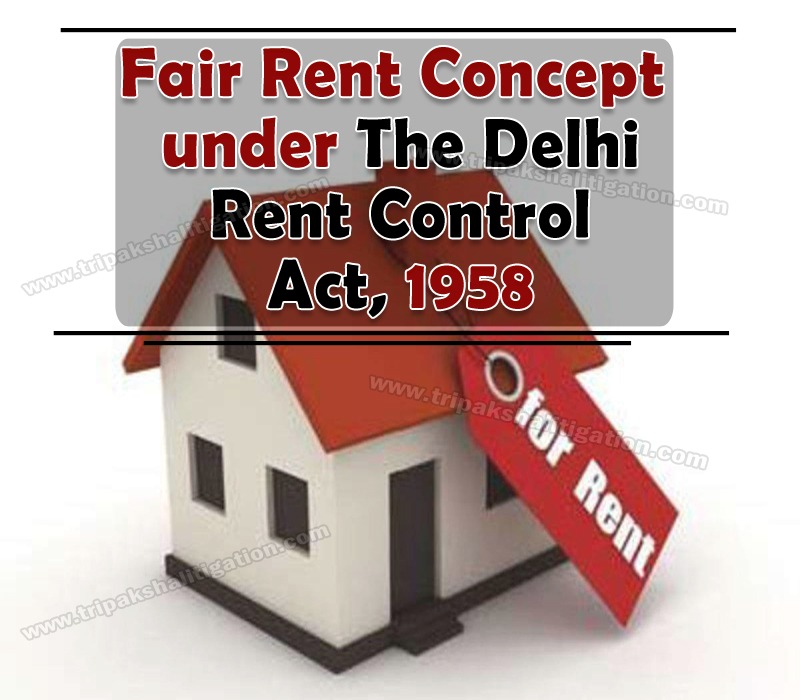The concept of Fair rent is present in Section 2 (c) of the Delhi Rent Control Act, 1958 and is defined in simpleton as market rent or a rent which besides giving a reasonable rate of return to the landlord also covers the variable costs of renting.
Fixing of fair rent is one of the many provisions of the Rent Control Act and is one of the biggest rights of the landlord. The basis of fixation of standard/ fair rent is the value of land and cost of construction when built.
In Delhi the concept of Fair Rent is applied on
- Areas in the limits of the New Delhi Municipal Committee, the Delhi Cantonment Board and the Municipal Corporation of Delhi
- Rooms in a hotel and lodging house. For determining Standard Rent public hospitals, educational institutions, public libraries, reading rooms and orphanages which are considered as residential premises for the purpose of fixation of fair rent.
In Delhi the concept of Fair rent is not applied on
- Any premises, whose monthly rental exceeds Rs.3500.
- Any premises belonging to the Government,
- Any premise rented through a grant from the Government.
- Any premises constructed after 1988, for a period of 10 years from the date of construction.
Calculation of fair rent
Standard rent is the rent which the land lord is expected to receive from the tenant. Standard rent is only provided if the property is under Rent Control Legislation .
The Delhi Rent control Act specifies that rent in excess of Standard Rent is not recoverable, except where rent is liable to periodical increase by virtue of an agreement entered into before the 1st of January 1939. Hence , if there is a written agreement in respect of increase of rent, then only it is payable.
Various basis of fixation of fair rent under Delhi Rent Control Act
There are many factors under the act which are to be considered such as the nature of property the standard rent and the date on which it is rented out before fixing the fair rent.
In the case of residential premises:
- Where such premises have been let out at any time before the 2nd day of June 1944)
- If the basic rent) of such premises <=Rs.600 p.a., the basic rent.
- If the basic rent of such premises >Rs.600 p.a., the basic rent + 10% of such basic rent.
- Where such premises have been let out at any time on or after the 2nd day of June 1944
- In any case where the rent of such premises has been fixed under the Delhi and Ajmer Merwara Rent Control Act, 1947 or the Delhi and Ajmer Rent Control Act, 1952- o If such rent p.a. <= Rs.1200, the rent so fixed. If such rent p.a. > Rs.1200, the rent so fixed together with 10% of such rent.
- In any other case, the rent calculated on the basis of 7.5% p.a. (8.25% if the rent so calculated exceeds Rs.1200 p.a.) of the aggregate amount of the reasonable cost of construction and the market price of land comprised in the premises on the date of the commencement of the construction.
- In the case of non residential premises:
- (Where the premises have been let out at any time before the 2nd day of June, 1944)
- The basic rent of such premises together with 10% of such basic rent (if the rent so calculated > Rs.1200 p.a., a rate of 15% will be used).
- Where the premises have been let out ant any time on or after 2nd June 1944)-
- In any case where the rent of such premises has been fixed under the Delhi and AjmerMerwara Rent Control Act, 1947 or the Delhi and Ajmer Rent Control Act, 1952- o If such rent p.a. <= Rs.1200, the rent so fixed o If such rent p.a. > Rs.1200, the rent so fixed + 15% of such rent.
- In any other case, the rent calculated on the basis of 7.5% p.a. of the aggregate amount of the reasonable cost of construction and the market price of the land comprised in the premises on the date of the commencement of the construction (where the rent so calculated exceeds Rs.1200 p.a., a rate of 8.625% shall be used).
Difference between Fair Rent and Standard Rent
Fair rent – It is the rent, a similar property in the same or similar locality can fetch.
Standard rent – It is fixed under the Rent Control Act where a higher rent than the standard rent cannot be expected by the owner.
Key takeaways from the article:-
- An increase of 10% in the standard rent after every three years in allowed.
- When the fair rent has been fixed under this Act, no further increase in the fair rent shall be allowed except in cases where some necessary addition, improvement or alteration has been carried out at the landlord’s expense with the approval of the tenant or the Controller. The standard rent may be increased per year by an amount not exceeding 15% of the cost of the additions.
- Where a landlord pays in respect of the premises any charge for electricity or water consumed in the premises or any other charge levied by a local authority having jurisdiction in the area which is ordinarily payable by the tenant, he may recover from the tenant.
- The landlord shall not recover from the tenant whether by means of an increase in rent or otherwise the amount of any tax on building or land imposed in respect of the premises occupied by the tenant.
There are many factors under the act which are to be considered such as the nature of property the standard rent and the date on which it is rented out before fixing the fair rent.
You may contact me for consultation or advice by visiting Contact Us








